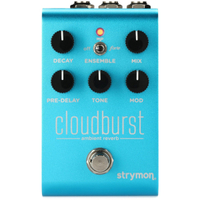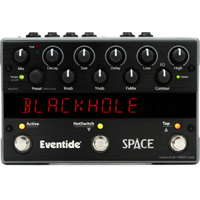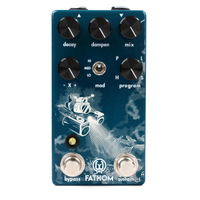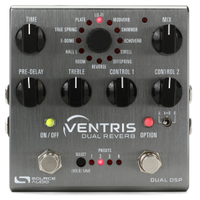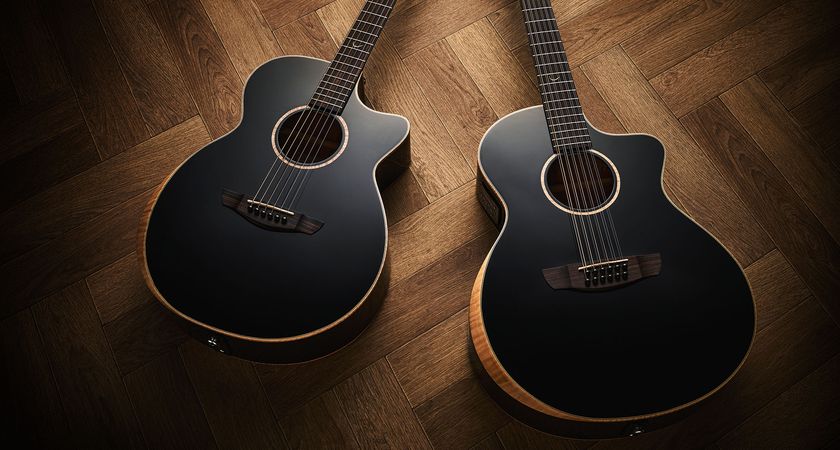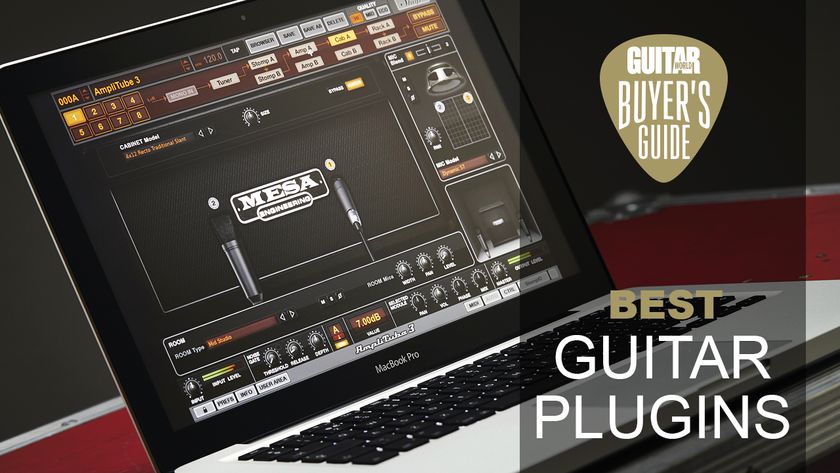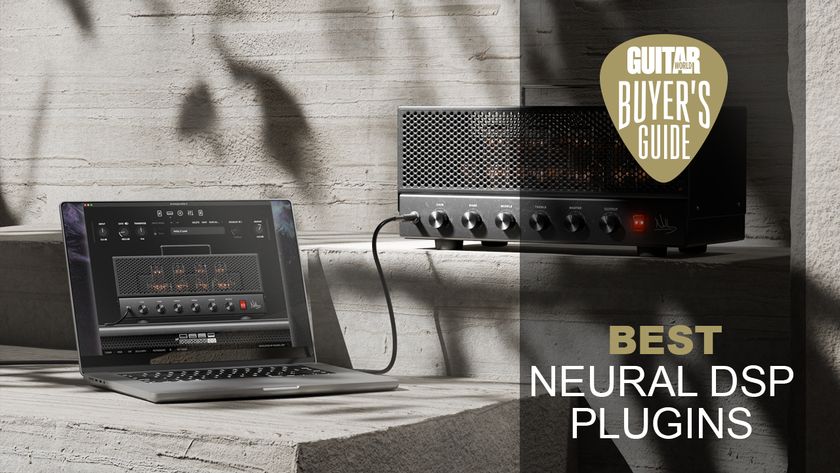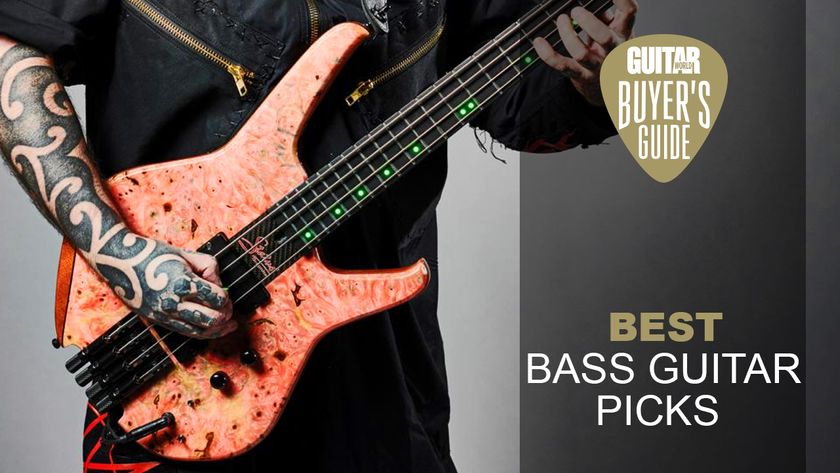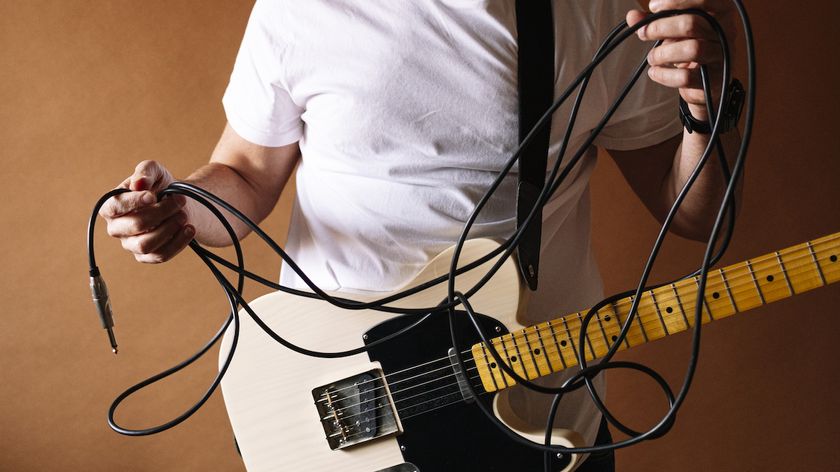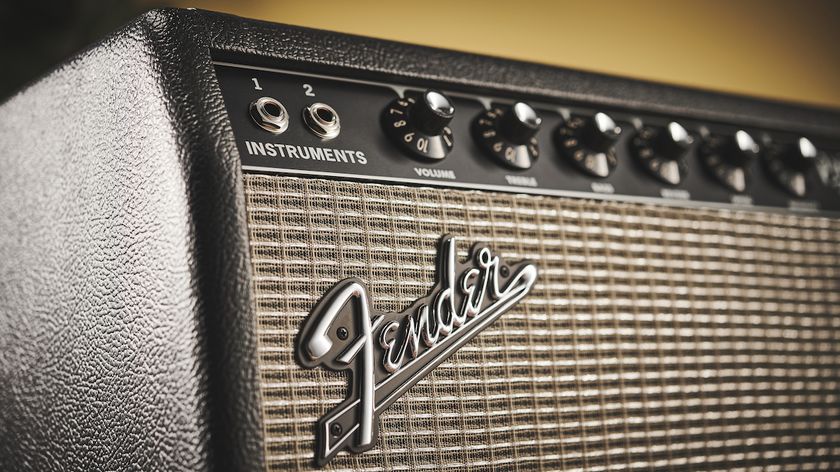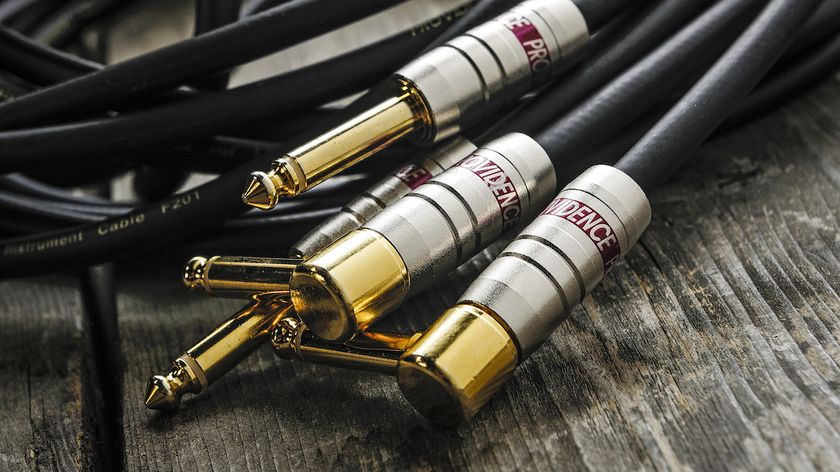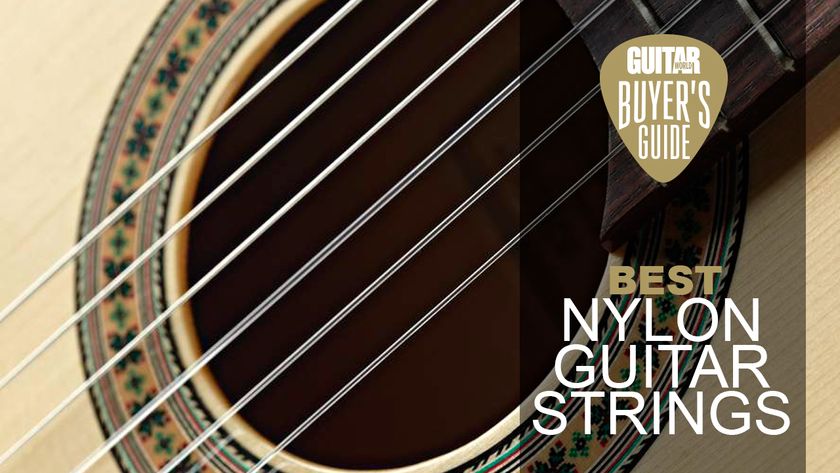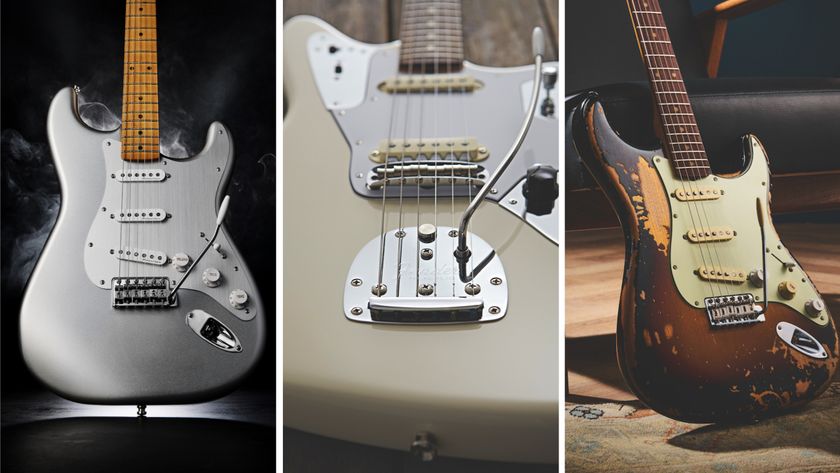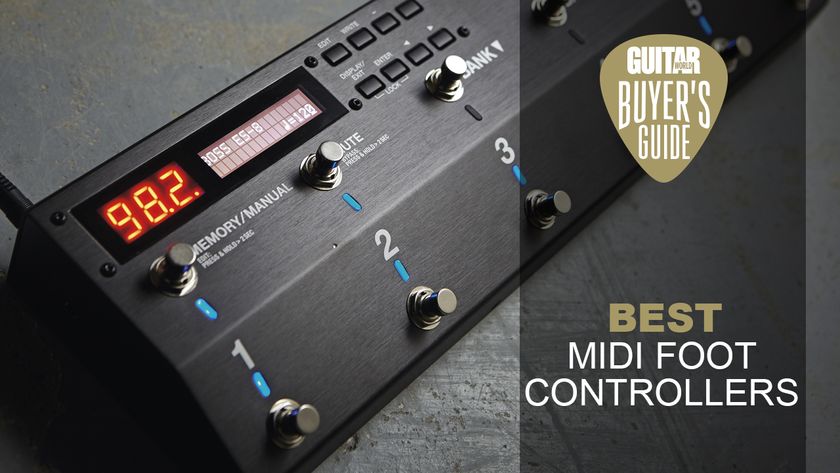Best reverb pedals 2025: from spring to shimmer, these are our top picks for your pedalboard
Take a deep dive into the cavernous world of 'verb and explore the best reverb pedals for every budget
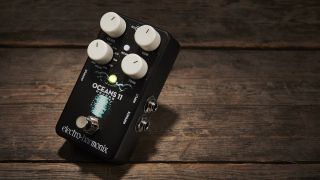
1. The quick list
2. Best overall
3. Best budget
4. Best beginner
5. Best gigging
6. Best ambient
7. Best stereo
8. Best multi-effect
9. Best spring
10. Best mini
11. Also tested
12. Buying advice
13. How we test
An effect you'll find on nearly all guitar player's pedalboards, the best reverb pedals can be a subtle underpinning of your tone or the catalyst to send it into the stratosphere.
We're all using reverb pedals on our own 'boards here at Guitar World, so we've got an excellent overview of what's out there to make you a perfect recommendation. With so many to choose from in 2024, it can be difficult to make a decision, and reverb pedals aren't cheap either so making that decision is even more critical if you're on a tight budget. Thankfully, we've tested loads of reverb pedals, using them at live gigs, during recording sessions, and in the comfort of our own homes. We've sorted everything by use case to make it easier to find your perfect match, whether you need something on a budget or a full-on workstation for ambient tones.
If you're new to the world of reverb pedals, make sure to have a look at our buying advice section which has loads of common questions answered by the experts here at Guitar World. If you just want to see the best reverb pedals you can buy right now, keep scrolling for our top picks...
The quick list
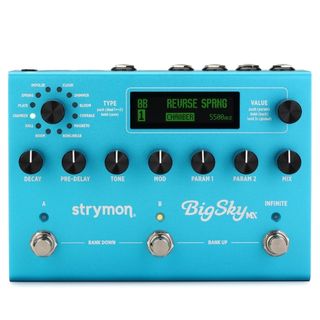
One of the most popular reverb pedals of all time, the Strymon BigSky MX is a welcome update. With a screen and usability improvement, one of the all-time greats just got even better.
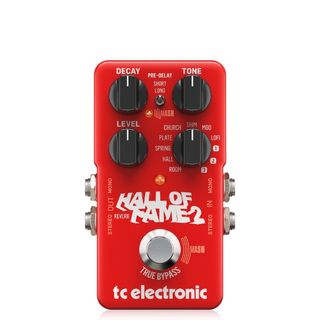
If you're after a quality reverb pedal on a budget, the TC Electronic Hall Of Fame 2 gives you loads of different quality reverb algorithms that won't break the bank.
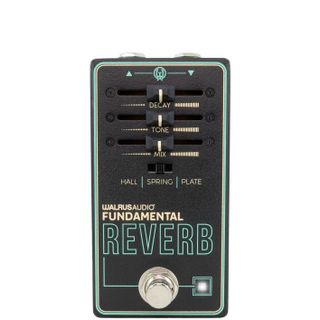
Three essential reverb types, a simple and sleek control interface and a switchable trails setting make the Fundamental Reverb a first-reverb must-have.
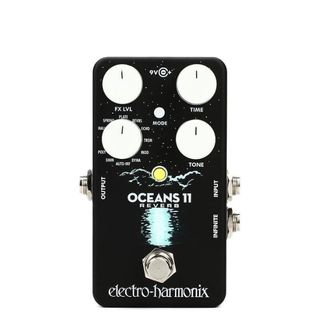
If you want an array of top-quality different reverb algorithms in a pedalboard-friendly enclosure, without having to spend loads, the Electro-Harmonix Oceans 11 is your perfect match.
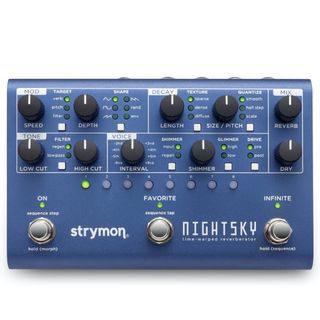
For those who like their soundscapes dripping in ambiance, the Strymon NightSky will deliver otherworldly sounds with an incredible array of functionality for truly unique reverb tones.
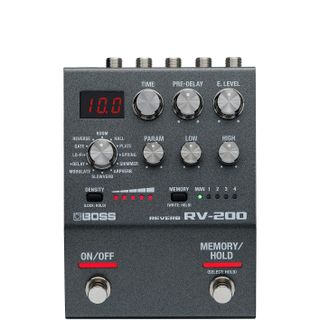
Taking the best of the RV-500 and adding an exciting new algorithm, the RV-200 is a space-conscious stereo-verb monster.
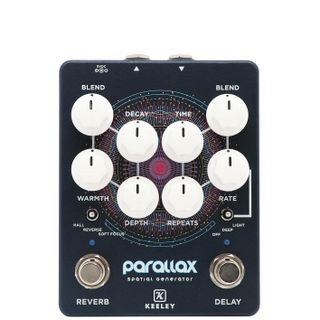
Keeley’s Parallax Spatial Generator is a successor to the Caverns delay-verb. Frankensteining the Caverns’ delay functionality with the 80s odd-verbs from the Keeley Realizer, the Parallax is quite simply shoegaze in a box.
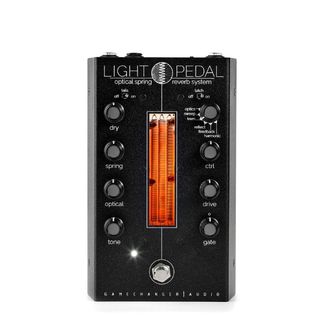
Spring reverb is a difficult one to get right, but the Gamechanger Audio Light absolutely nailed it. It's not cheap, but it's as close as you'll get to a spring reverb tank in a pedal.
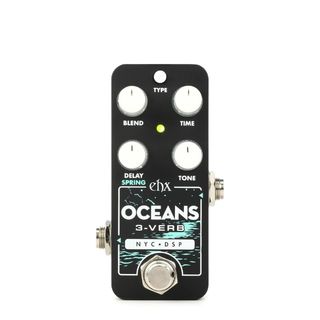
Packing spring, plate, and hall reverbs into a teeny-tiny enclosure, the Electro-Harmonix Pico Oceans 3-verb is a fantastic choice for those short on pedalboard real estate.
Best overall
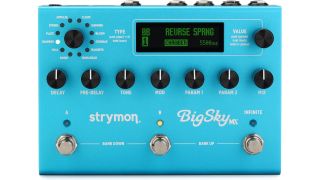
1. Strymon BigSky MX
Our expert review:
Specifications
Reasons to buy
Reasons to avoid
Strymon’s name is rightfully and indelibly associated with ‘quality’; gigging musicians have turned to Strymon’s unassailable range of pro-quality products for years, with a slew of top-name and session guitarists swearing by their versatility live and in-studio. The BigSky reverb is one such workhorse – and it’s received a mega update.
The Strymon BigSky MX is practically a BigSky remaster, with dramatically improved internal hardware and entirely new subsets of features. The bones of the BigSky remain, in its 12 powerful reverb algorithms and endless adjustability. There’s something new, though at every turn.
For one, there are seven new or updated reverbs to play with, one of which is the truly game-changing Impulse setting – an IR editor that places convolution reverb thrillingly at your feet. For another, your BigSky MX is actually two BigSkys, capable of engaging two reverbs at once, routed whichever way you like.
New reverbs, endless IR possibilities, and quality-of-life updates like a new OLED screen make the BigSky MX far more than a BigSky Mk2; this is a formidable upgrade, and an indispensable addition to the professional pedalboard.
Best budget
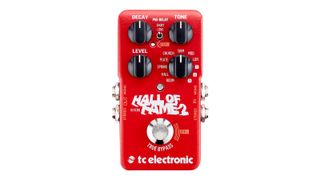
2. TC Electronic Hall Of Fame 2
Our expert review:
Specifications
Reasons to buy
Reasons to avoid
The sequel to TC’s best-selling Hall Of Fame takes the successful formula - which spans the typical spring, plate, and church settings, plus mod and lo-fi sounds - and adds a host of extras.
Besides a polyphonic shimmer mode, the HOF2 boasts TC’s pressure-sensitive MASH technology, which allows you to adjust the intensity of the reverb depending on how hard you push on the footswitch.
Three slots are onboard to store TonePrint presets, too - you can use TC’s computer or app-based editor to create your own sounds, as well as download artist presets. Considering the cost of this pedal, you get a whole lot of bang for your hard-earned bucks here.
Best beginner
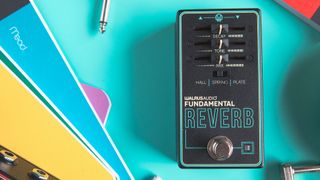
Specifications
Reasons to buy
Reasons to avoid
Walrus Audio is a brand best known for its boutique output – but it’s recently brought its boutique expertise to the entry level, with an impressive roster of accessible pedals called the Fundamental Series.
The Fundamental Reverb shares the same austere control surface as its siblings, bearing three slider pots and a three-way slider switch. The switch gives you access to three different reverb algorithms – Hall, Spring and Plate – each of which are bread-and-butter in their own right, and lush in their own way.
The basic controls make the Fundamental Reverb extremely beginner-friendly, and do not majorly impede more fidget-friendly players either. This is because the algorithms are stage-ready out of the box, and bad sounds are near-impossible to find within them. That said, more experienced players might miss being able to control each reverb’s damping.
The Fundamental Reverb isn’t without its clever boutique-y touches, though, as evidenced by a smart trails-toggling parameter accessed by holding the footswitch down. As far as budget reverbs go, this is a highly practical utility with boutique-quality reverb algorithms – and an unmissable deal.
Read our full Walrus Audio Fundamental Reverb review
Best gigging
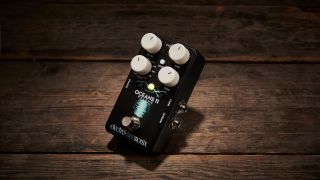
4. Electro-Harmonix Oceans 11
Our expert review:
Specifications
Reasons to buy
Reasons to avoid
The lower left rotary switch knob on the Oceans 11’s front panel gives the strongest indication of the complexity lurking within this diminutive device. Here, users will find 11 different settings that consist of hall, spring, plate, reverse, echo, tremolo, modulated, dynamic, auto-infinite, shimmer, and polyphonic effects.
Several of these effects - tremolo, modulated, and dynamic - have three different sets of parameters that can be selected with the mode switch. The mode switch also selects tap tempo divisions for the echo setting and engages either interval or mix edit parameters for the Poly setting. Other controls include an FX level, time (decay), and tone knobs, with the latter two also providing a second set of parameters that are accessible by holding down the mode button for about one second.
The sound quality of all of the effects is stellar, boasting smooth tails and pro-studio-quality noise-free performance. The spring reverb setting is based on a 1962 Fender 6G15 reverb unit and delivers some of the best spring reverb effects you’ll ever hear. Echo combines delay and reverb, while tremolo applies a tremolo effect to both wet and dry hall reverb.
Shimmer is an ethereal, octave-up reverb effect with a long, sustaining tail that produces a synth-like texture, and the polyphonic reverb applies two programmable pitch shifts to the reverb tail to also generate complex, synth-like sounds.
Whether you want outstanding versions of bread-and-butter reverb effects, complex and unusual special effects, or a combination of both, the Electro-Harmonix Oceans 11 Reverb is a worthy and highly affordable contender for any pedalboard, large or small - and is easily one of the best Electro-Harmonix pedals in their lineup right now.
Read the full Electro-Harmonix Ocean's 11 review
Best ambient
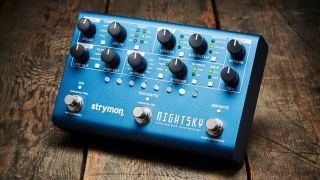
Specifications
Reasons to buy
Reasons to avoid
Even for those used to complex pedals and software plug-ins, the NightSky is initially daunting. However, its saving grace is that more-or-less every parameter is accessible quickly via a control on the front panel.
There are three main modes. Sparse is a tap-delay-based reverb, Dense is more of a plate-style reverb, and Diffuse, as the name implies, is more of an ambient reverb. The tap delay mode can put you in the ballpark of more standard delays as well, further adding to the versatility of the NightSky.
There are dedicated controls on the front panel for adding harmonic intervals, shimmer reverb tails, and modulation to the core reverb sound, plus a footswitch to trigger an infinite reverb mode.
Finally, there's also a step-sequencer in the NightSky, presumably to add experimental options akin to those in the Hologram Infinite Jets and Microcosm. It's not clear that it's a USP in the context of the NightSky, which is more of a studio reverb workstation than an esoteric weirdo box.
Read the full Strymon NightSky review
Best stereo
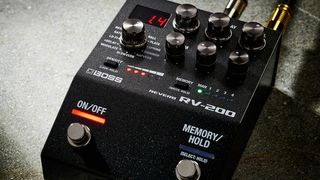
Specifications
Reasons to buy
Reasons to avoid
Boss’ RV-500 was a long-awaited reverb workstation from the legacy pedal brand, folding popular and historic Boss reverbs into a single mega-pedal with peerless functionality. Price and size were major limiting factors for this comprehensive reverb, though – and its latest sibling addresses both without sacrificing quality.
The Boss RV-200 is a pint-sized multi-reverb unit, putting the best of the RV-500 at your feet in a plug-and-play stompbox format. There are 12 reverb algorithms to choose between, and extensive parameter customisation for each (without the menu-diving complexity of the RV-500).
There’s also a boon in the form of Boss’ all-new Arpverb patch – a unique, gleaming, ever-ascending digital reverb marrying shimmer-verb with the magic of synth arpeggiation. All effects benefit from Boss’ proprietary 32-bit floating point processor, and an absurdly high sample rate of 96khz.
Though missing the extensive adjustability of its big brother, the RV-200 is an immensely powerful addition to the pedalboard – and space-friendly, to boot.
Read our full Boss RV-200 review
Best multi-effect
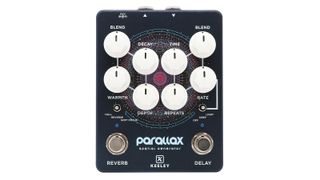
7. Keeley Parallax Spatial Generator
Our expert review:
Specifications
Reasons to buy
Reasons to avoid
Keeley Electronics is the pedal brand’s pedal brand, brainchild of designer, modder and inveterate tinkerer Robert Keeley. From the early days of Blues Driver mods and the Keeley Compressor to today’s remarkable roster of expansive effects, Keeley has made some hall-of-famer pedals – and the Parallax Spatial Generator is the latest to join the party.
The Keeley Parallax Spatial Generator is something of a successor to the hugely versatile Caverns Delay and Reverb. The Parallax keeps the Caverns’ delay, but replaces its reverb with that of the Keeley Realizer Reverberator – a woozy love-letter to ‘80s rack reverbs and the inventiveness of early shoegaze music.
The result is a mesmerising one-stop shop of ethereal soundscapes and modulated miasmas, ranging from soft-focus ‘80s rack verbs to Cocteau-Twins-y reverse effects. The jack sockets are wired as TRS inserts, meaning you can use Y-splitter cables to create an effects loop between the delay and the reverb.
The Parallax’s dreamy sounds are unparalleled, even if they could be a little more versatile. Still, this is a powerful dual-effect reverb that contains multitudes.
Best spring
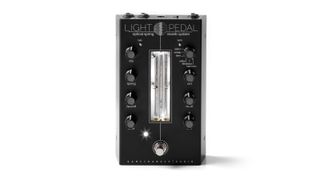
8. Gamechanger Audio Light Pedal
Our expert review:
Specifications
Reasons to buy
Reasons to avoid
It’s less common than you may first think to see genuinely unique pedals hit the market. We expect to see overdrive pedals based on stompboxes from the late 70s, chorus pedals based on the iconic Boss circuit, and relatively standard bucket brigade delay pedals, so it’s refreshing to see something we have never seen before – and Gamechanger Audio seems to do this with every release.
The Light Pedal is GCA’s attempt at redefining what a reverb pedal can be. Combining a real spring tank with an innovative infrared optical sensor system, the Light Pedal can be used to create brand-new sounds we guarantee you’ve never heard before.
This mega pedal includes six types of reverb, which can all be adjusted with the control knob, and better yet, the clever gate knob allows you to dramatically shorten the reverb tails and even create ducking effects. Oh, and in case you were worried about mechanical spring noise while you stomp around the stage, it’s okay, the built-in shock sensor is designed to eliminate that problem.
Best mini
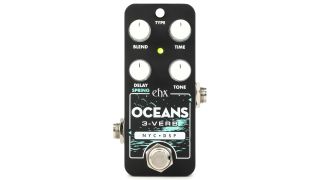
9. Electro-Harmonix Pico Oceans 3-verb
Our expert review:
Specifications
Reasons to buy
Reasons to avoid
If you need a mini reverb pedal for your busy pedalboard, we'd go for the Electro-Harmonix Pico Oceans 3-verb. Taking three of the algorithms from the excellent Oceans 11 we mentioned earlier, it's great for those that need a simple but effective reverb pedal when space is tight.
The reverb sounds available are super solid, giving you spring, plate, and hall options that will have a range of bases covered. You can dial in some pretty heady stuff too if you prefer your 'verbs more atmospheric via the plate and hall settings. We found the spring reverb to be really good as well, perfect for surf and psychedelic tones.
You also get an infinite freeze feature if you want to get even more experimental, available on both the hall and plate settings. Great if you're into your noise and drone type washes of noise, it takes the 3-verb beyond just another mini-reverb pedal into something far more versatile.
Also tested
For us, the pedals we've listed above are the best of the best. That said, we've tested loads of different reverb pedals so if you're looking for something a little different, here are some more of our favorites.
Strymon Cloudburst | 1 reverb | 300 presets (MIDI) | Stereo | Expression in
Guitarists have long been hoping for the epic sound of a Strymon in a smaller unit, and now we’ve got it with the Strymon Cloudburst. This little blue box is only small in stature though, delivering huge, ambient tones that will no doubt please the shoegazers and experimentalists out there.
Guitar World Score: 4.5/5
Read our full Strymon Cloudburst review
Eventide Space | 12 reverbs | 100+ presets | Stereo | Expression in
Eventide’s Space boasts a wide variety of spatial effects, including basic reverbs, delays, and unique combination effects, with 12 of the company’s studio-level reverb combo algorithms. There are also more than 100 factory presets and a huge array of connectivity options.
Guitar World Score: 4.5/5
Walrus Audio Fathom | 4 reverbs | Sustain function | Mono
Walrus Audio’s multi-function reverbs offers a practical array of thoroughly usable reverb types - hall, plate, lo-fi, and Sonar - each with a preset-specific parameter. The hall and plate settings really shine here, while lo-fi’s filtered tones offer some gnarly textures for more ambient players.
Guitar World Score: 4.5/5
Source Audio Ventris | 14 reverbs | 2 simultaneous | Stereo | Expression in
The Ventris comes from digital pedal experts Source Audio, and its killer app is the ability to run two fully independent reverbs from one modestly proportioned pedal. So, you could send one reverb left, and one right, stack one into another, or run both at once in parallel for epic trails.
Guitar World Score: 4.5/5
Buying advice
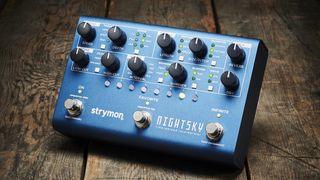
What does a reverb pedal do?
The reverb pedal is, in essence, a space simulation station. Natural reverbs are the result of sound bouncing off reflective surfaces; reverb pedals use a variety of methods to create an artificial version of this effect, giving the illusion that you’re playing in anything from a small, pingy room to a huge, boomy cathedral. Some reverb pedals go even further beyond, creating completely impossible spaces with additional effects like chorus, reverse-sample playback and octave-shifting.
How to choose the best reverb pedal for you
You can trust Guitar World
If you’re a bread-and-butter guitarist looking for a pedalboard-based alternative to the sparse, quintessential amp-verb sounds of Stevie Ray Vaughan or Mark Knopfler, you’ll need little more than a decent spring reverb emulator. Many less-featured or entry-level reverb pedals have a spring reverb patch included, and the few controls they possess are generally more than enough – providing the patch itself sounds to your liking.
If you play a little more broadly, then you’ll want a multi-effect reverb pedal with different options or patches. Ask yourself what kind of sounds you’d like to choose between, and what parameters you’d like to be able to change. Would you like to be able to set presets, too, or are you content with noodling around the knobs and switches?
If you’re hoping to take your playing off into the stratosphere, then you won’t be too fussed about accurate room- or amp-sound reverbs; instead, you’ll be looking for a more esoteric ambient or pad reverb pedal. These kinds of pedals have super-long tails, and often feature a ‘freeze’ or ‘hold’ function that can be used to create an endless bed of ‘verb. In pedals like these, tone controls are vital, as they help you sculpt a non-intrusive verby fog for your playing to float over, under or between.
What makes a good reverb pedal?
No two pedalboards are quite the same, and there’s no universal answer when it comes to choosing a reverb pedal to add to your own chain. The sheer variety of reverb pedals on the market today can be daunting, but the potential they represent is thrilling.
Ultimately, there’s no real right or wrong when it comes to picking your own reverb. Your best bet for making the ‘right’ decision is to listen to some pedals in action. Ask yourself whether you like what you’re hearing, and whether you’ll like it against the sounds you already utilise.
As a professional guitarist with studio sessions or live shows coming up, you might have some cause to concern yourself with specifications like sample rate or processing power – but even the most sought-after session musicians in the world don’t let ‘bad’ specs get in the way of a good sound. So go forth, and get lost! (in reverb.)
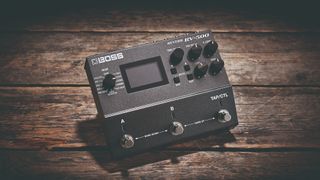
Where does reverb go in the pedal chain?
We always like to say there are no hard and fast rules on where you should place your pedals, but if you’re new to reverb, we’d start by placing it at the end of your chain. Reverb is designed to simulate space, and spaces usually hear the sound coming from your amp.
With this in mind, putting your reverb at the end of your chain is the closest you’ll get to that same effect. All the better if your amp has an effects loop, which can be used to place your reverb (and other time-based effects) after your amp’s pre-amp and EQ stages for a cleaner, more controlled result. However, placing your reverb earlier in your chain can yield uniquely exciting results.
Placing your reverb before other modulation effects lets you effect the tails of your ‘space’, leading to a more cohesive and dynamic sound. Placing a reverb before your dirt stage can give you colorful grit, or blown-out shoegaze-y soundscape a la Kevin Shields.
Experimentation will yield wildly different results based on the contents of your own pedalboard, so don’t be afraid to move things around in the name of science!
What are the key differences between different reverb pedals?
The vast majority of reverb pedals you will encounter are digital reverb pedals. This means they use digital signal processing technology, or DSP, to create their reverb effects. Digital signals are ‘verbed in two main ways – algorithmic reverb, and convolution reverb.
Analog reverb pedals are far less common, but by no means impossible to find. Analog reverb effects are achieved by routing an analog audio signal through a resonant material or assembly, the most famous example of which is spring reverb. Good spring reverbs are usually both sizeable and costly, but innovation continues even in this most old-school of fields, with the likes of Gamechanger Audio re-inventing analog spring reverb for a new generation.
What is the difference between algorithmic and convolution reverb?
Algorithmic reverbs, up until very recently, were the primary form of digital reverb in pedal form. They use calculus to create artificial spaces with near-limitless possibilities, combining numerous timed delays with banks of filters to sculpt the sound’s reflections and tails.
Convolution reverbs, meanwhile, are reverbs created from real-life samples of reverberant spaces. Impulse responses (IRs) are audio files comprising a short, percussive noise or sine-wave sweep and a space’s resulting reverb – which a convolution plugin can then combine with your signal, making it sound as if you’re playing in the very same space.
Convolution reverb is a computationally-taxing process, and until recently only short IR samples could be used in pedals (i.e.: guitar cabinet simulators). Now, leaps in microprocessor design have allowed the power of convolution reverb to come to the guitar pedal – with Strymon’s BigSky MX the biggest example of its pedal potential so far.
Convolution reverbs are ideal for simulating a real space, but algorithmic reverbs can create unreal spaces – and are responsible for quintessential ambient and ethereal reverbs, like the Eventide Space’s craziest patches.
Why are reverb pedals so expensive?
Unfortunately, reverb is one of the most expensive effects out there and this is because of the computational power that’s required to take your guitar’s signal, simulate it being played through digital space, and play it back at you, all in real-time. A mixture of complex algorithms and powerful computer chips is required to handle this workload and still deliver a top-quality tone, hence the associated cost. If you’re on a budget, not all is lost though, there are some budget reverb pedals available if you look hard enough that still deliver a great sound.
Are reverb pedals worth it?
In our opinion, absolutely yes. Reverb is probably the most used effect in the whole of music and was certainly one of the first effects that were ever used. Way back when loudspeakers were being played into a recording studio's bathroom to create a sense of space, right through to today’s wild soundscapes that are possible thanks to advanced digital signal processing, reverb is a must-have effect for any guitar player. It is an investment, but trust us, it’s totally worth it.
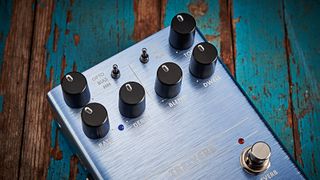
Are all reverb pedals digital?
Reverb is, for the most part, a digital effect. This is because for it to be analog, you’d need something physical to play your sound through. Early reverb effects like the plate reverb required huge metal sheets through which the sound was played. Echo chambers had sounds played into them which were then captured by a microphone and added to the dry signal to create a sense of space on the recording. So as you can imagine, it’s pretty inconvenient to use an analog reverb outside of the studio or sound design spaces.
That said, spring reverbs had a physical spring that the sound was played through to create it’s metallic twang, and you can still get these analog-type reverbs today, usually found built into amplifiers. Gamechanger Audio and Danelectro both do physical spring reverb pedals too, bringing analog sound straight to your pedalboard.
How we test reverb pedals
When testing any reverb pedal we like to put it through a rigorous process that would simulate exactly how any guitarist would use it. As guitarists ourselves, this might mean putting it on our own 'board, taking it to rehearsals and shows, as well as using it for recordings too.
We like to get straight to business when testing a pedal, so we start off by hooking it up to our pedalboard and seeing how it works off the bat. We're looking at whether it's easy to dial in sounds, how you can configure things on the fly, and whether or not everything is clearly marked.
Of course, some reverb pedals are far more complex than others, so we may need to dive into the manual on those units. But ultimately what we're trying to find out is how usable it is for the average guitarist, whether you're one to look at a manual or not.
We'll test all of the available sounds on both clean and dirty guitar tones, using our keenly trained ears to determine how well they react to different effects. We'll try various blends from a touch of 'verb to full-on Kevin Shields-style reverse reverb tricks if the pedal is capable, making certain we've covered every sound possible.
We'll also look to see how well the controls can affect the sound, whether that's sculpting via EQ or adding modulation. Reverb can be a very consuming effect so it's important to see how flexible a particular pedal can be, particularly when integrating with dirty guitar tones.
Finally, we'll look at the build quality of the unit. Ultimately we're trying to determine how well it will put up with life on the road, as many of these pedals will be used for live guitar playing. We'll check over each pedal in detail to ensure it can put up with plenty of use and abuse, as well as using it ourselves at live shows or in rehearsals to see how it deals with the pressure.
Read more about how we test products and services and how we make our recommendations.
Related buyer's guides
- Go all-in-one with the best multi-effects for guitar
- Bring the dirt with the best fuzz pedals around
- Get all wobbly with the best tremolo pedals
- Get top-notch sound with the best amps for pedals
- Power up with the best pedalboard power supplies for every budget
- Get great tone with the best impulse response loaders
Get The Pick Newsletter
All the latest guitar news, interviews, lessons, reviews, deals and more, direct to your inbox!

Mike is Editor-in-Chief of GuitarWorld.com, in addition to being an offset fiend and recovering pedal addict. He has a master's degree in journalism from Cardiff University, and over a decade's experience writing and editing for guitar publications including MusicRadar, Total Guitar and Guitarist, as well as 20 years of recording and live experience in original and function bands. During his career, he has interviewed the likes of John Frusciante, Chris Cornell, Tom Morello, Matt Bellamy, Kirk Hammett, Jerry Cantrell, Joe Satriani, Tom DeLonge, Ed O'Brien, Polyphia, Tosin Abasi, Yvette Young and many more. In his free time, you'll find him making progressive instrumental rock under the nom de plume Maebe.
- Alex Lynham
- Matt McCrackenJunior Deals Writer
- Richard Blenkinsop
- Daryl RobertsonSenior Deals Writer
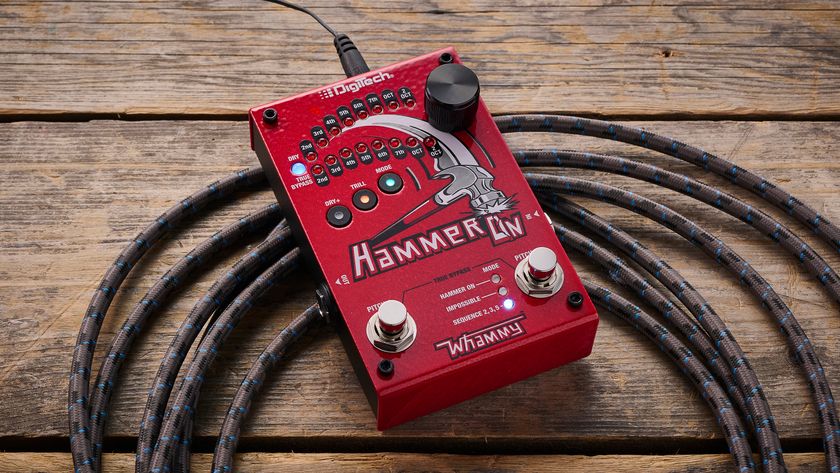
“It can make you a legato-monster like Satch, give you EVH-level tapping skills, or turn your guitar into a synth sequencer”: DigiTech HammerOn review
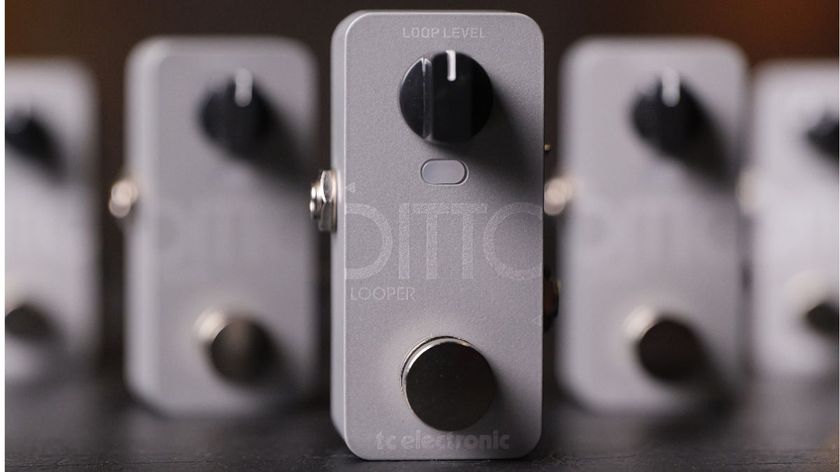
“Redefining a winning formula”: TC Electronic upgrades its beloved looper with the Ditto 2 – but can it keep up in an increasingly competitive market?
